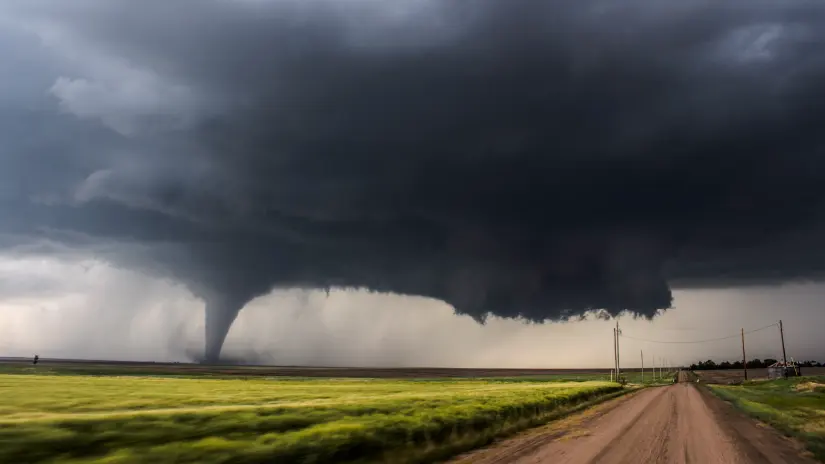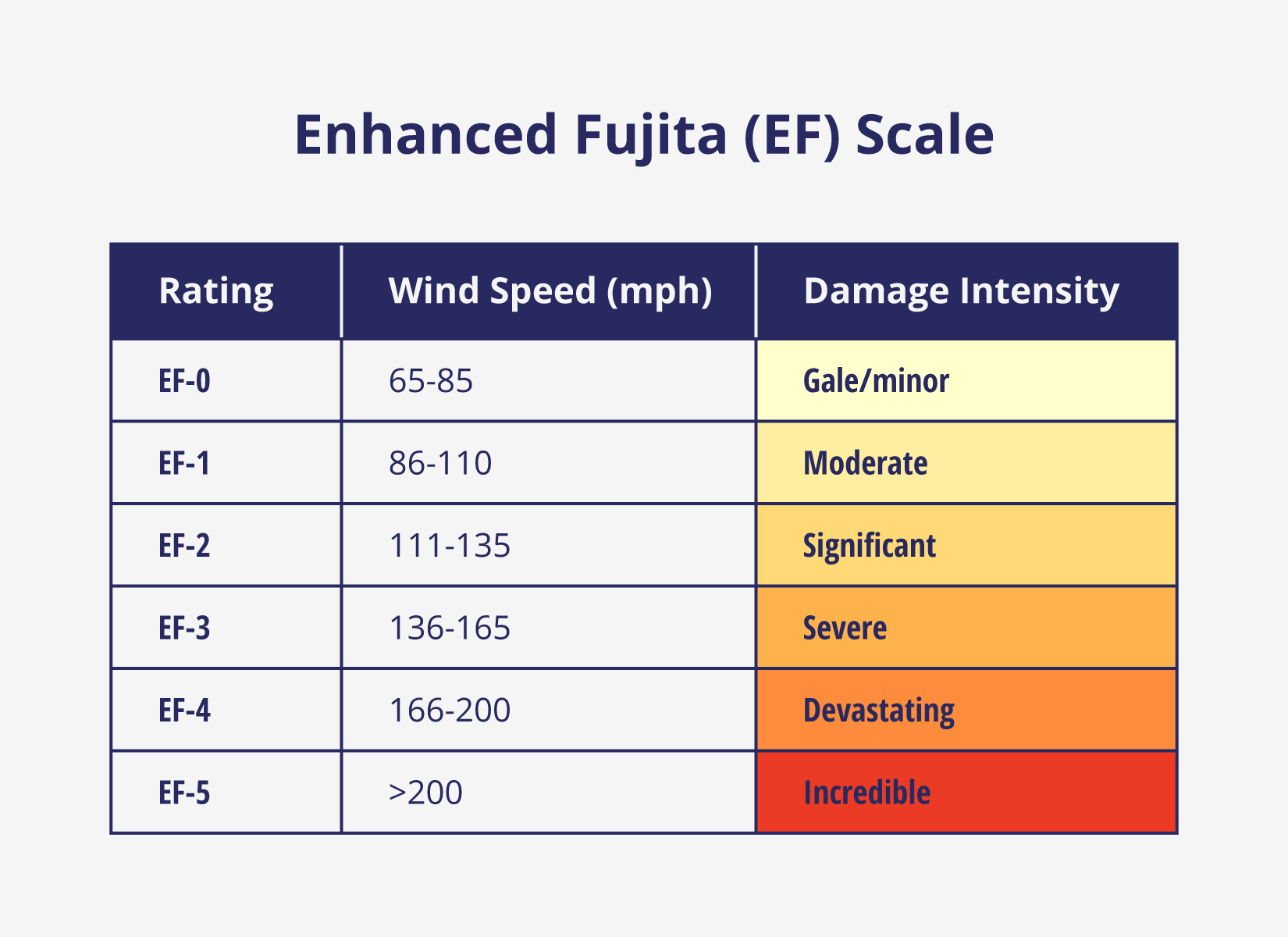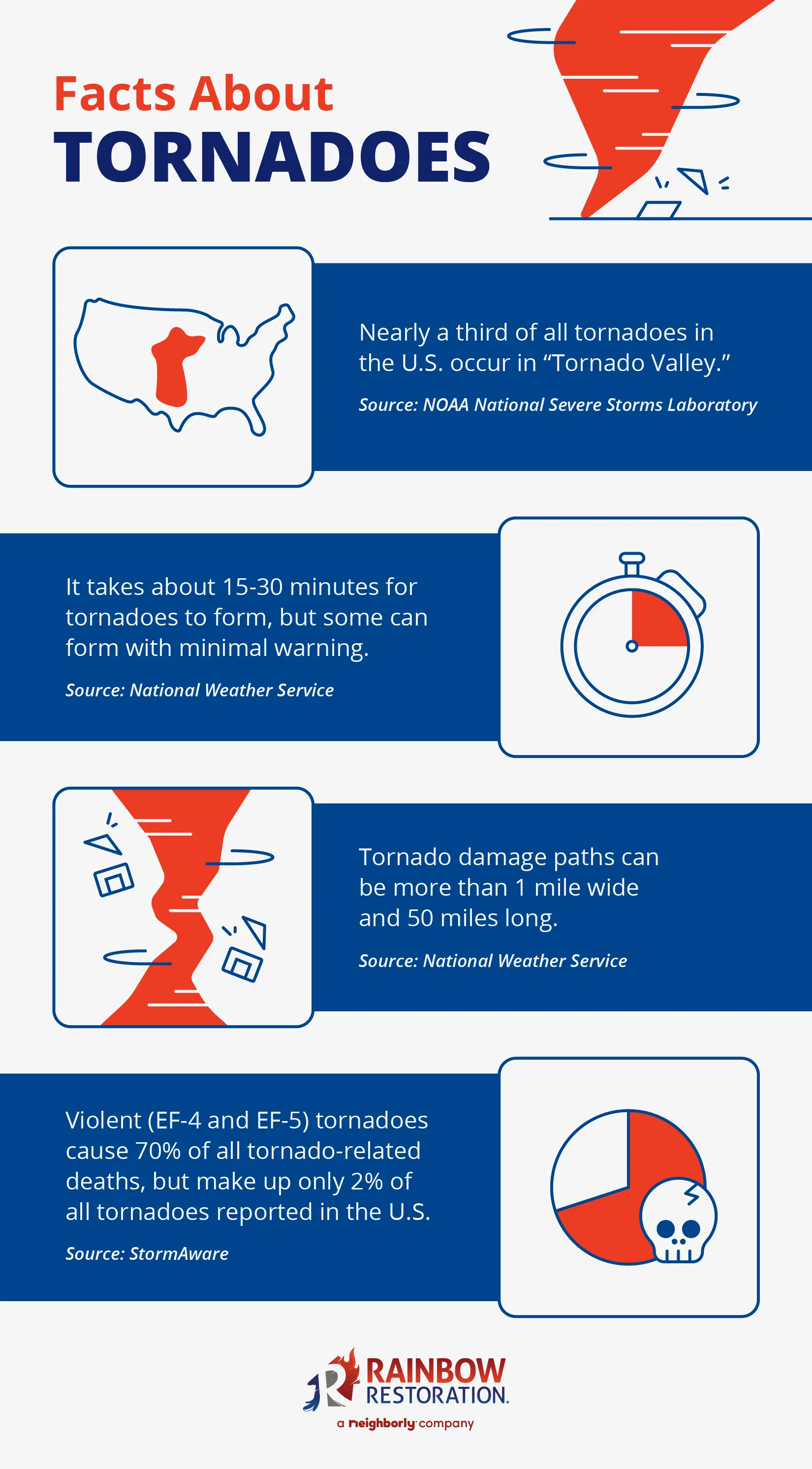
The Fujita Scale, as explained by Rainbow Restoration, is a system for rating tornado intensity based on damage caused.
|
Originally Published May 6, 2016
Tornado categories are measured through what’s known as the Enhanced Fujita Scale, or the EF Scale. It’s the standard tool used to categorize tornadoes based on the scope of the storm damage they cause.
Explore the six different EF Scale categories, ranging from weak to devastating, to understand the threat level posed by a tornado.
Understanding the Enhanced Fujita Scale and tornado categories can help communities better prepared to stay safe during these dangerous weather events, prevent damage to property, and have a recovery and restoration plan in place.

What Is the Enhanced Fujita Scale?
The Enhanced Fujita Scale is a way of rating a tornado’s intensity. The intensity is based predominately on the wind speed and the structural and vegetation damage the storm creates.
The National Weather Service’s meteorologists, engineers, and scientists classify tornadoes based on the Enhanced Fujita Scale. The scale has six categories, EF-0 through EF-5, with EF-5 being the most damaging storm.
No matter the category, prepare to act quickly when a tornado watch or warning is issued. Knowing what to do can save lives and help prepare for storm damage.
EF-0 Tornado
Wind Speed: 65-85 mph
Classification: Gale/minor
While often brief, EF-0 tornadoes can still cause damage.
Possible damage includes:
- Roof shingles loosened or ripped off
- Damaged siding on buildings and homes
- Shallow-rooted trees pushed over
EF-1 Tornado
Wind Speed: 86-110 mph
Classification: Moderate
With winds between 86 and 110 mph, EF-1 tornadoes can cause significant damage, even to well-built structures.
Possible damage includes:
- Roofs ripped off buildings
- Mobile homes overturned
- Large branches snapped from trees
EF-2 Tornado
Wind speed: 111-135 mph
Classification: Significant
EF-2 tornadoes are considered the first level of strong tornadoes on the Enhanced Fujita Scale. With wind speeds significantly faster than freeway speed limits, EF-2 tornadoes can wreak havoc on buildings and land.
Possible damage includes:
- Entire roofs of buildings and structures ripped off
- Large trees uprooted
- Boxcars overturned
EF-3 Tornado
Wind speed: 136-165 mph
Classification: Severe
Compared to the lesser tornado categories, EF-3 tornadoes can cause widespread devastation, such as leveling well-constructed houses or causing major roof and wall failures. The destructive winds can also generate large and dangerous debris from ripped-apart structures.
Possible damage includes:
- Strong, framed houses completely destroyed
- Large trees snapped or uprooted
- Heavy objects such as cars thrown through the air
- Buildings with weak foundations lifted off their foundations
EF-4 Tornado
Wind speed: 166-200 mph
Classification: Devastating
EF-4 tornadoes are rare but terrifying forces of nature. With wind speeds reaching a staggering 166 to 200 mph, they can cause catastrophic damage to entire neighborhoods, and turn ordinary objects into high-speed missiles.
EF-4 tornadoes are statistically rare, accounting for only about 2% of all tornadoes reported in the United States.
Possible damage includes:
- Well-constructed buildings leveled
- Cars and large objects thrown long distances
- Dirt and vegetation scored from the earth
EF-5 Tornado
Wind speed: >200 mph
Classification: Incredible
EF-5 tornadoes — the most destructive tornado classification — boast wind speeds exceeding 200 mph, making them the most powerful winds recorded on Earth. Picture entire buildings completely leveled, vehicles tossed around like toys, and massive debris generated by the destructive winds.
Possible damage includes:
- Vehicles of all sizes shredded and thrown miles away
- Completely demolished neighborhoods and towns
- Entire landscapes scoured and flattened
Less than 1% of all tornadoes reported in the United States have been categorized as EF-5, but they remain a sobering reminder of the importance of preparedness for severe weather events.
What Is the Difference Between the Fujita and Enhanced Fujita Scale?
The Fujita Scale, developed in the 1970s, was the first scientific attempt to rank tornadoes based on the damage they caused.
However, the Fujita Scale had limitations. It relied on an investigator's interpretation of the damage, which could be subjective. Additionally, building codes and materials varied across locations and over time, making it difficult to accurately compare tornadoes from different areas or eras.
The Enhanced Fujita Scale was introduced in 2007 to address these shortcomings with a more standardized approach. The new scale considers wind speed estimates derived from detailed damage indicators, such as building types, structural damage, and tree damage. It also takes into account building code variations to provide a more accurate assessment of the intensity across different regions.
| Fujita Scale | Wind Speed (mph) | Enhanced Fujita Scale | Wind Speed (mph) | Damage Intensity |
|---|---|---|---|---|
| F-0 | 40-72 | EF-0 | 65-85 | Gale/minor |
| F-1 | 73-112 | EF-1 | 86-110 | Moderate |
| F-2 | 113-172 | EF-2 | 111-135 | Significant |
| F-3 | 158-206 | EF-3 | 136-165 | Severe |
| F-4 | 207-260 | EF-4 | 166-200 | Devastating |
| F-5 | 261-261-318 | EF-5 | >200 | Incredible |
How To Prepare for Tornadoes
Tornadoes can strike with surprising speed and ferocity, leaving little time for reaction. Being prepared in advance is critical for safety. By taking proactive steps to develop a plan, assemble an emergency kit, and identify safe shelter locations, businesses and property owners can significantly increase their chances of staying safe during a tornado event.
Here’s how to prepare for this sort of threat:
1. Prepare Your Property
While there's no way to completely tornado-proof a property, certain measures can strengthen a home or business against high winds and flying debris. Here are a few ways to fortify a property against a tornado:
- Install impact-resistant windows or storm shutters to protect a property from windblown objects.
- Consider adding bracing to garage doors to prevent them from collapsing.
- Remove or securely anchor loose objects such as outdoor furniture, signage, grills, or decorations that could become projectiles in a tornado.
- Trim overhanging tree branches that could break and damage a roof or nearby power lines.
- If property does suffer damage from the storm, contact a trusted restoration provider for emergency board-up services and roof tarping.
2. Understand the Signs of a Tornado
The sooner the warning signs of a tornado emerge, the more time there is to seek safe shelter. Early detection can provide precious minutes to react, though tornado warnings may not always come through in time.
Telltale signs of an oncoming tornado include:
- A rotating, funnel-shaped cloud extending from a thunderstorm toward the ground.
- A loud roar, similar to a freight train, caused by the moving wind.
- An approaching cloud of debris, especially near the ground.
- A sudden and significant change in air pressure, creating an eerie calm or quiet.
- Very dark or greenish-colored sky within a thunderstorm.
3. Create a Tornado Emergency Plan
A well-defined tornado emergency plan can mean the difference between confusion and decisive action during a critical moment. Here's how to create a plan to ensure safety in the event of a natural disaster:
- Assemble a team: Discuss tornado safety with all property occupants. Assign roles and ensure everyone understands their responsibilities.
- Pick a safe place: Identify a designated shelter location in a home or building, ideally a basement or an interior room on the lowest level away from windows and exterior walls.
- Prepare an emergency kit: Stock a kit with essential supplies to last for at least a few days.
- Practice makes perfect: Conduct regular tornado drills. Walk through the process of seeking shelter and ensure everyone knows where to go and what to do.
- Stay informed: Sign up for local weather alerts and monitor weather forecasts during severe weather threats.
4. Set Notifications for Tornado Alerts
Tornadoes most often occur during the spring and summer months, particularly between March and June. While certain parts of the country are struck more than others are, tornadoes can hit anywhere. It is a good idea to set notifications for tornado alerts on your phone to stay informed.
There are two types of tornado alerts:
- Tornado watch: Tornadoes are possible in the area. Be prepared in case a warning comes by confirming a designated area or safe room to allow quick action.
- Tornado warning: A tornado has been sighted or indicated by weather radar. This means that there is danger and to seek shelter immediately.
5. Build an Emergency Preparedness Kit
A well-stocked emergency kit is vital for surviving a tornado and its aftermath. Having essential tornado shelter supplies readily available can make a big difference during a stressful situation. Here's what to include in a tornado preparedness kit:
- Nonperishable food: Pack enough food for at least three days to sustain everyone taking shelter. Choose options that don't require cooking or refrigeration, such as canned goods, energy bars, and granola bars.
- Water: Stockpile at least one gallon of water per person per day for three days. Consider including water purification tablets or a water filter in case clean water becomes scarce.
- First-aid kit: Be prepared for potential injuries by including bandages, antiseptic wipes, pain relievers, and any prescription medications.
- Flashlight and batteries: Power outages are common after tornadoes. Pack a reliable flashlight with extra batteries to ensure a source of light.
- Battery-powered radio and extra batteries: Stay informed about the situation by having a battery-powered radio on hand.
- Cash and important documents: Keep a small amount of cash on hand in case ATMs or credit card systems are unavailable. Include copies of important documents such as passports, insurance papers, and identification cards in a waterproof container.
These are just the basics — more can always be added to the kit to fit specific needs. Consider including additional items such as a whistle to signal for help, a dust mask for dust storms after the tornado, and a basic toolkit for minor repairs.
6. Seek Shelter
In the event of a tornado warning, it's crucial to have a predetermined safe space in your home or business for occupants to go to. A designated tornado shelter, if available, offers the most protection.
However, if time is short and there isn’t a storm shelter available, here are a few other options:
- In a home or business: The lowest level of a building generally provides the most safety. Ideally, this should be an interior room on the ground floor, located away from windows and exterior walls. A basement is the best choice, but a small central bathroom or closet can also offer some degree of protection.
- In a building: If caught outside during a tornado warning, seek shelter inside a sturdy building away from windows and glass. Large open areas such as cafeterias, gymnasiums, or auditoriums should be avoided, as these can collapse during a tornado.
- As a last resort: If suitable shelter isn’t available within a building, lie flat in a low-lying ditch or other depression in the ground, covering your head with your arms. This position helps shield you from flying debris.
Facts About Tornadoes
While the Fujita scale provides a general idea of a tornado’s catastrophic potential, below are some additional facts about tornadoes, from how they form to the destructive forces they unleash:
- The United States experiences the most tornadoes globally, with an average of 1,200 tornadoes per year.
- "Tornado Alley" (Texas to Mississippi Valley) accounts for nearly a third of all U.S. tornadoes.
- There are an average of 1,200 waterspouts — tornadoes that form over water and can reach speeds of up to 150 mph — reported globally each year.
- It takes an average of 15-30 minutes for a tornado to fully form, but some tornadoes can form with minimal warning.
- Tornado damage paths can be more than 1 mile wide and over 50 miles long.
- Tornadoes may be nearly transparent until they pick up dust and debris or a cloud forms within the funnel.
- Tornadoes are the fastest rotating winds on Earth, with recorded wind speeds exceeding 300 mph.
- Flying debris produced from tornadoes causes over 70% of tornado-related deaths and injuries.
- Violent (EF-4 and EF-5) tornadoes cause 70% of all tornado-related deaths but make up only 2% of all tornadoes reported in the U.S.
- The most destructive tornadoes occurred in the U.S. August 8-12, 2020, across 16 different states, with an estimated $9.2 billion in damages.
- More than three-fourths of tornadoes in the U.S. are considered weak (EF-0 or EF-1).
- 95% of all U.S. tornadoes are below EF-3 intensity.
- Only 0.1% of tornadoes are classified as EF-5.

Tornado Categories FAQ
How Are Tornadoes Classified?
Tornadoes are rated by the damage they cause, which helps meteorologists and scientists determine their wind speed. The worse the damage, the higher the category and the more dangerous the tornado.
What Is the Fujita Scale for Tornadoes?
The Fujita Scale — which was updated in 2007 and renamed the Enhanced Fujita Scale — rates tornadoes on a scale of EF-0 to EF-5, with EF-5 tornadoes being the most devastating. Ratings are based on the damage the tornado causes.
How Many Tornado Categories Are There?
There are six tornado categories included on the Enhanced Fujita Scale: EF-0, EF-1, EF-2, EF-3, EF-4, and EF-5.
Is an EF-5 Tornado Worse Than an F5?
Not necessarily. An F5 tornado, categorized using the outdated Fujita Scale, has recorded wind speeds between 261-318 mph.
A tornado categorized as EF-5 based on the updated Enhanced Fujita Scale has recorded wind speeds over 200 mph, which may or may not exceed an F5 tornado. In the rare event that wind speeds exceed 318 mph, the EF-5 tornado is definitively worse than an F5 is.
Is an F6 Tornado Possible?
There has never been an (E)F-6 tornado recorded, but they’re technically not impossible. An F-6 tornado would need to reach wind speeds beyond 318 mph; however, the highest wind speeds ever recorded on Earth were 302 mph.
How Bad Is a Category 1 Tornado?
A category 1 tornado is on the lower end of the scale, but it can still cause significant damage, like ripping off roofs or flipping cars. However, well-built structures typically hold up fairly well.
Find Professional Storm Damage Repair Near You
While the Enhanced Fujita Scale provides a helpful way to understand tornado strength, it's important to remember that no tornado is safe. Even the weakest tornado category can cause injuries and property damage.
If your residential or commercial property has been damaged by a tornado or heavy storm contact Rainbow Restoration® to quickly restore your property and get you back to normalcy.
If you have a need for storm damage restoration, call us now for emergency services.
This article is intended for general informational purposes only and may not be applicable to every situation. You are responsible for determining the proper course of action for your property. Services should be performed by licensed and experienced professionals. Rainbow Restoration is not responsible for any damages that occur as a result of this blog content or your actions. For the most accurate guidance, contact a Rainbow Restoration professional for a custom, on-site assessment.
